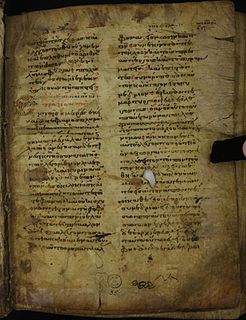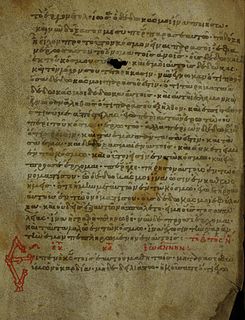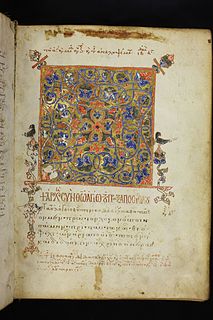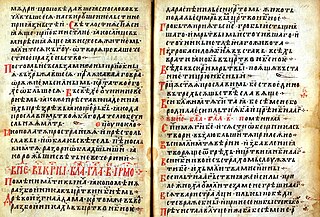 W
WThe Gospels of Tsar Ivan Alexander, Tetraevangelia of Ivan Alexander, or Four Gospels of Ivan Alexander is an illuminated manuscript Gospel Book, written and illustrated in 1355–1356 for Tsar Ivan Alexander of the Second Bulgarian Empire. The manuscript is regarded as one of the most important manuscripts of medieval Bulgarian culture, and has been described as "the most celebrated work of art produced in Bulgaria before it fell to the Turks in 1393".
 W
WThe Holkham Bible is an illustrated collection of biblical and apocryphal stories in Norman French. It was produced in England during the decades before 1350 for use by an unidentified Dominican friar. The illustrations depict the stories in contemporary English settings, making it a visual source on medieval English society. Previously part of the library of Holkham Hall, Norfolk, the Holkham Bible is now held by the British Library.
 W
WLectionary 86, designated by siglum ℓ 86, is a Greek manuscript of the New Testament, on parchment leaves. It is dated by a colophon to the year 1336.
 W
WLectionary 170, designated by siglum ℓ 170 is a Greek manuscript of the New Testament, on parchment leaves. Palaeographically it has been assigned to the 14th century. Scrivener dated it to the 12th or 13th century. Formerly it was labelled as Lectionary 68a. Scrivener by 65a.
 W
WLectionary 226, designated by siglum ℓ 226 is a Greek manuscript of the New Testament, on parchment. Palaeographically it has been assigned to the 14th century. F. H. A. Scrivener labelled it by 249evl. Some leaves of the manuscript were lost, and some leaves have survived in a fragmentary condition.
 W
WLectionary 227, designated by siglum ℓ 227 is a Greek manuscript of the New Testament, on parchment. Palaeographically it has been assigned to the 14th century. Scrivener labelled it by 250evl. Many leaves of the manuscript were lost, some leave have survived in a fragmentary condition.
 W
WLectionary 298 (Gregory-Aland), designated by siglum ℓ 298 is a Greek manuscript of the New Testament, on parchment. Palaeographically it has been assigned to the 14th century. The manuscript has complex contents.
 W
WLectionary 313 (Gregory-Aland), designated by siglum ℓ 313 is a Greek manuscript of the New Testament, on parchment. Palaeographically it has been assigned to the 14th-century. The manuscript has survived in a fragmentary condition.
 W
WMinuscule 223, α 263, is a Greek minuscule manuscript of the New Testament, on parchment. Palaeographically it has been assigned to the 14th-century. Formerly it was labeled by 223a and 277p. Scrivener labelled it by 220a and 264p.
 W
WMinuscule 480, δ 462, is a Greek minuscule manuscript of the New Testament, on parchment. It is dated by a colophon to the year 1366. The manuscript is lacunose. The manuscript was adapted for liturgical use. It has marginalia. It contains liturgical books with hagiographies: Synaxarion and Menologion.
 W
WMinuscule 716, ε448, is a Greek minuscule manuscript of the New Testament, on parchment. Palaeographically it has been assigned to the 14th century. The manuscript is in the British Library as Egerton MS 2784. The manuscript has complex contents. Scrivener labelled it as 565e.
 W
WMinuscule 833, Θε421, is a 14th-century Greek minuscule manuscript of the New Testament on paper. The manuscript has complex contents.
 W
WMinuscule 834, Θε422, is a 14th-century Greek minuscule manuscript of the New Testament on parchment. The manuscript has complex contents.
 W
WMinuscule 836, Θε46, is a 14th-century Greek minuscule manuscript of the New Testament on paper. The manuscript has not complex contents, it lacks Gospel of Luke.
 W
WMinuscule 837, ε415, is a 14th-century Greek minuscule manuscript of the New Testament on parchment. The manuscript is lacunose.
 W
WMinuscule 2060 (in the Gregory-Aland numbering), Av42 (von Soden), is a Greek minuscule manuscript of the New Testament, on 105 parchment leaves (27.5 by 21 cm). It is dated by a colophon to the year 1331. Gregory labelled it by 153r, Scrivener by 114r.
 W
WThe Munich Serbian Psalter is a 14th-century illuminated psalter written in Church Slavonic of the Serbian recension. With its 229 leaves illustrated with 148 miniatures, it is regarded as the most extensively illuminated Serbian manuscript book. It was written after 1370 in Moravian Serbia, either for its ruler Prince Lazar, or more likely, for his successor Stefan Lazarević. The book was rebound in 1630 by Serbian Patriarch Pajsije. It was taken to Bavaria in the late 17th century, and has been kept in the Bavarian State Library in Munich since the beginning of the 19th century.
 W
WCodex Oriental Ms. 424, designated by siglum A1 (Horner), t (de Lagarde [= Boetticher]), is written in two languages Bohairic-Arabic, uncial manuscript of the New Testament, on paper. It is dated by a colophon to the year 1308. Many leaves of the codex were lost.
 W
WAl-Ousta Codex, also known under its library classification BnF 1314-1315, is a 14th-century illuminated Bible codex containing the 24 canonical books of the Hebrew Bible, written in Sephardi square script with the Tiberian sublinear vocalisation, minuscule trope symbols, and the Masorah Magna and Parva. Others place the writing of the codex in the 15th-century. The manuscript was purchased by ethnographer Jacob Sapir in San'a, Yemen in 1859, who carried it with him to France. Today, the manuscript is housed at the Bibliotheque Nationale de Paris.
 W
WThe Pirdop Apostle is a Bulgarian script book in Bulgarian language from Elena Basilica scriptorium near Pirdop, now kept in the SS. Cyril and Methodius National Library. It consists of the Acts of the Apostles with 130 surviving parchment leaves, the beginning and end parts being lost. It initially contained all the texts of the Acts and the Letters of the Apostles, but now only the Letters are preserved. It dates from the 13th century. In the 19th century the book was discovered immured in a niche of the church known as the "Elena Basilica" of "St. Elijah" monastery near to the small Bulgarian town of Pirdop. The Monastery and church was looted and completely destroyed by the Ottoman Army in 1700. According to a palaeographic analysis of the preserved transcript, this is a late counterfeit, probably from the first half of the 19th century.
 W
WShem Tob's Hebrew Gospel of Matthew is the oldest extant Hebrew version of the Gospel of Matthew. It was included in the 14th-century work Eben Boḥan by the Spanish Jewish Rabbi Shem-Tov ben Isaac ben Shaprut. George Howard has argued that Shem Tov's Matthew comes from a much earlier Hebrew text that was later translated into Greek and other languages. A characteristic feature of this Hebrew gospel is the appearance in 20 places of השם, in the abbreviated form ה״, where the Gospel of Matthew has Κύριος.
 W
WThe Wenceslas Bible or the Bible of Wenceslaus IV is a multi-volume illuminated biblical manuscript written in the German language. The manuscript was commissioned by the King Wenceslaus IV of Bohemia and made in Prague in the 1390s. The Wenceslas Bible is unique and very precious not only because of its text, which is one of the earliest German translations of the Bible, but also because of its splendid illuminations. This oldest German deluxe Bible manuscript remained uncompleted.